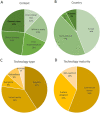Uptake of Technology for Neurorehabilitation in Clinical Practice: A Scoping Review
- PMID: 37856528
- PMCID: PMC10851848
- DOI: 10.1093/ptj/pzad140
Uptake of Technology for Neurorehabilitation in Clinical Practice: A Scoping Review
Abstract
Objective: Technology-based interventions offer many opportunities to enhance neurorehabilitation, with associated research activity gathering pace. Despite this fact, translation for use in clinical practice has lagged research innovation. An overview of the current "state of play" regarding the extent of clinical uptake and factors that might influence use of technologies is required. This scoping review explored the uptake of technologies as neurorehabilitation interventions in clinical practice and factors that are reported to influence their uptake.
Methods: This systematic scoping review was conducted with narrative synthesis and evidence mapping. Studies of any design reporting uptake or implementation of technology (wearable devices, virtual reality, robotics, and exergaming) for movement neurorehabilitation after stroke and other neurological conditions were sought via a formal search strategy in MEDLINE (Ovid), CINAHL, AMED, and Embase. Full-text screening and data extraction were completed independently by 2 reviewers.
Results: Of 609 studies returned, 25 studies were included after title, abstract, and full-text screening. Studies investigated a range of technologies at various stages of development. Only 4 of the included studies explored the sustained use of technology in practice. The following 5 themes representing experiences of technology use emerged: perceived usefulness, technology design, social interaction, integration with services, and suggested improvements to enhance uptake.
Conclusion: Reporting of uptake and use of neurorehabilitation technologies in clinical practice is limited. The synthesis provided comprehensive knowledge of barriers to and facilitators of uptake to be considered in future protocols, including a steep learning curve required to engage with technology, a need for a supportive organizational culture, and a need for user involvement in both design and development.
Impact: This scoping review has provided indicators from current evidence of important factors to consider in the planning of research into and clinical implementation of technologies for neurorehabilitation. It serves to support an evidence-based, user-centered platform for improved research on and translation of technologies in neurorehabilitation clinical practice.
Keywords: Neurological; Neurological Conditions; Rehabilitation; Scoping; Technology; Translation; Uptake.
© The Author(s) 2023. Published by Oxford University Press on behalf of the American Physical Therapy Association.
Figures



References
-
- Hancock NJ, Pomeroy V, Dorer C, et al. Action plan for production of the next generation of movement rehabilitation technologies. Synapse. 2018;Autumn:4–9.

